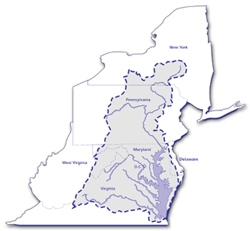Animal Farming in the Chesapeake Bay
|
The Chesapeake Bay Watershed encompasses 64,000 square miles, with a land-to-water ratio of 14:1. The Bay has more land draining into it relative to its volume of water than any other bay in the world! Currently, 22% of the land in the Chesapeake Bay Watershed is involved in agriculture. A large portion of this is used for animal farming. Animal farming can be industrial or family run; family farms are smaller and more adversely affected by national and state regulations. Animal farming is an important part of the economy. For example, in Virginia, there are more than 300 turkey farms and 800 chicken farms, supporting approximately 1,200 farm families. Virginia's poultry processing companies employ over 10,000 people, and for every processessing job, there are 7.2 two jobs created outside the industry. There are six major types of animals being raised in the Chesapeake Bay Watershed: dairy cows, beef cattle, pigs, hens for egg production, broilers (chicken) and turkeys. There are 185 million livestock animals present. Livestock products account for over 60% of farm sales. Between 1950 and 2002, the number of farms in the watershed fell approximately 75%, from about 350,000 to 100,000. Similarly, the total acreage declined 45%, from 33.7 to 18.5 million during the same time period. These losses are the result of a growing population and increased urban development. Costly new management practices and increases in the costs of fuel and operational expenses, on top of a weak economy and diminishing profits, have exacerbated the situation. |
|
|
Source: The Chesapeake Bay Foundation, The Chesapeake Bay Program, and the VA Farm Bureau | |

